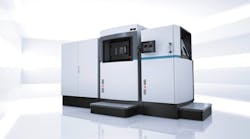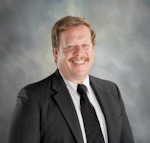Jim Montague is the executive editor for Control. Email him at [email protected].
Maybe lithography, sintering and printing aren't the right words. Too dainty and two-dimensional. Maybe welding and forging would be better because they suggest more power, impact and depth.
This is because traditional metalworking terms more accurately describe what's going on when 3D laser-sintering machines from Electro Optical Systems melt and build up layers of metal into pretty much anything their users can imagine and design. Of course, 3D printers that produce fantastical plastic objects seem to be everywhere these days, but only a few of these 3D printers work with metal, and those like EOS' that can create large pieces in industrial volumes are rarer still.
EOS was founded way back in 1989 by Dr. Hans Langer, who had been involved with a firm working as an R&D contractor for BMW to develop a stereolithography (SLA) process using photo-curable liquid resins. Their early vision was to develop a similar selective laser-sintering (SLS) process, which could melt thermoplastic nylon or semi-crystalline powders with a CO2 laser. Since then, the inventors of SLA and SLS have cross-licensed their technologies to nurture the still young and quickly emerging field of additive manufacturing.
"EOS invented powder-bed, metal printing in 1992, and so we hold about 700 patents in 100 patent families. We cross-license with our competitors because it's good for making our industry grow," says Andrew Snow, senior vice president, EOS of North America.
Also Read: Hydroforming For Machine Builders Gets 21st-Century Makeover
The company is headquartered in Krailling, Germany, near Munich, and its North American technical center is in Novi, Michigan. EOS now has more than 500 employees, including one-third devoted to R&D and engineering, and it spends 15 to 18% of its revenue on development. As a result, EOS has more than 1,500 installs worldwide, including many in the U.S. Its users make parts and other products for aerospace, medical, automotive, industrial, consumer products and other manufacturers.
The EOS M 400 direct-metal laser-sintering (DMLS) system uses a 1-kW laser in a 400 x 400 x 400-mm building volume to produce 3D-printed parts in many metal alloys.
Besides this cooperation, Snow reports that many hard-won technical and material improvements have aided the emergence of EOS and other additive machine builders. "Many developments in the laser industry have had major impacts, but I think the biggest breakthrough came in 2006-07 when we were able to switch from CO2 lasers to single-mode, diode-pump, fiber-optic lasers, which enabled 3D printers to process a variety of new alloys, including many types of aluminum, steel, stainless steel and titanium," Snow says. "As more technical improvements came along, such as digital scanners for better laser steering and higher-wattage lasers, which enable faster and more efficient printing, we added them. Also, where a CO2 laser could only run at 200 watts, today's typical fiber-optic laser can run at 200, 400 or 1,000 watts. And, while the largest, traditional 3D-printed projects are about 250 mm, our maximum part geometry is now a 400-mm cube."
Though 3D laser printers require fewer automation and control components than traditional subtractive devices such as machining centers, they still require controls similar to those used in other laser-based cutting and marking equipment. In this case, CAD/CAM files are downloaded into and "sliced up" by EOS' proprietary PSW software, which then drives its printers' laser-scanning heads, galvanometers, mirrors and two-axis spindles. After the system deposits a fine layer of metal power on its build platform, the lasers and mirrors trace each design layer before another layer is added, which progressively builds up or "grows" each part.
The ability to run faster at higher power, process more different metals and materials, handle larger projects with more complex geometries and achieve greater throughput, all enable EOS to differentiate its machines from the ubiquitous, but less-capable 3D printers built for and used mostly by hobbyists and others in the growing do-it-yourself or maker communities. "Smaller players and tabletop printers are fine, but EOS is dedicated to high-volume, industrial 3D printing and manufacturing," Snow explains. "In addition, the metallurgical properties of our laser-sintered parts are much better than cast parts and, in many cases, they're equal to wrought, forged or bar-stock materials. What we're doing isn't so much laser sintering as it is micro welding."
More recently, EOS introduced 3D laser printing for 316 stainless steel, and developed and introduced printing of Hastelloy nickel-based alloy. "We've analyzed many different metals and alloys for 3D laser printing, and we commercialize them when we find a market," Snow says.
Once a laser-printing program is complete and its part is finished, the leftover metal powder is removed and recycled into the next build project. Next, finished parts can undergo post-production work, such as further machining, finishing and polishing. Snow adds this demonstrates that EOS doesn't want to replace traditional machining technologies, but instead use its additive methods to cooperate with traditional subtractive technologies. "Subtractive and additive can can work in tandem on the plant floor, and many users already find ways to do it," Snow adds. "For example, some users employ our 3D printers to quickly make parts for their pick-and-place equipment or end-of-arm tooling machines."






